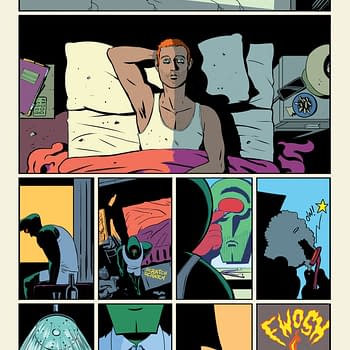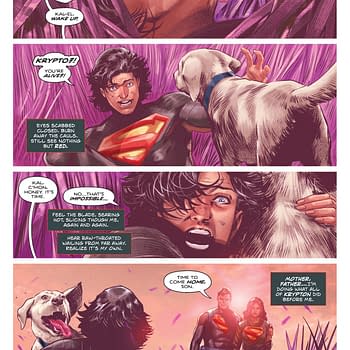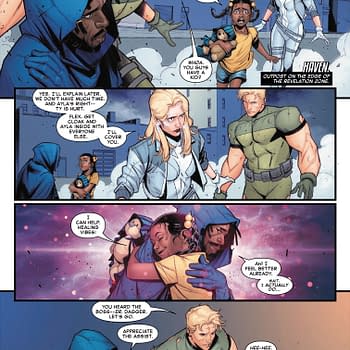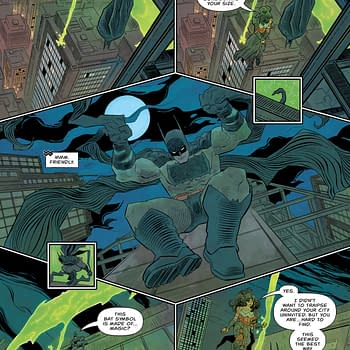Posted in: Comics, Recent Updates | Tagged: 2000ad, Brass Sun, Comics, d'israeli, entertainment, ian edginton, INJ Culbard, Matt Brooker, sherlock holmes, steampunk, Stickleback, The Hound of the Baskervilles
'A Step To The Side And Into The Shadows' – Ian Edginton Discusses The Big Reveal Of Stickleback's Identity In 2000AD (SPOILERS)
This week, Prog 1911 of 2000AD has a Stickleback cover for a significant reason other than the gorgeous artwork by D'Israeli. In the enclosed installment of Stickleback, a serialized story that's been running since 2006, readers will learn the Pope of Crime's true identity, long hinted at as we've witnessed his chameleon-like ability to manifest different and surprising personality traits that have rendered him a very unconventional villain. One might even call him an anti-hero.
Well, writer Ian Edginton joins us here today to talk all the details of this major revelation, the why, how, and what this may mean of it, since Stickleback looks to be set for future installments building on these developments. One thing is clear, given his history and experience as a writer, not to mention his imagination and enthusiasm, Edginton is the right man for this job for a number of reasons. Read on to find out why…
[***SPOILERS, REALLY LOTS. DON'T READ FURTHER WITHOUT CAUTION]

Ian Edginton: First and foremost, one of the best things is simply being able to write such character as Stickleback. I deliberately wanted the villain to be the hero. I wanted him to be roguish, charismatic and blissfully amoral.
When I was growing up in the 'sixties and 'seventies in the UK, there were several comic series that had the villain as the protagonist. There was the Black Max – World War One German fighter ace Baron von Klor taking down the enemy allies with his giant bats or Kingbats. Then there was The Spider, the self-proclaimed King of Crooks, created by writer Ted Cowan and artist Reg Bunn, Superman co-creator Jerry Siegel took over writing the character for his later adventures. These saw him shift from villain to hero and were a definite influence on the creation of Stickleback.
Some of my own personal highlights from writing the series have been cooking up the bad guys that Stickleback has to face down. If he's bad, they have to be worse. There was the monstrous cowboy cannibal Buffalo Bill Cody and his circus of Lovecraftian nightmares, the automata fixated Countess Irena Bernoulli – the illegitimate lovechild of Charles Babbage and Lady Ada Lovelace. She had all of her parents' genius coupled with her grandfather's (Lord Byron's) amoral appetites.
Then there was the half man/half dinosaur Dr Jekyll and Mr. Hyde and in this current series there are the Three Sorrows based on a section from Thomas De Quincey's Suspiria de Profundis: Mater Lachrymarum (Our Lady of Tears) Mater Tenebrarum (Our Lady of Darkness) and (Mater Suspiriorum) Our Lady of Sighs. The director Dario Argento used them in his Three Mothers horror trilogy but I've taken them in a different direction and cast them as the Nephilim-like off spring of Lilith (Adam's first wife) and an otherworldly entity.
There are also Chinese hopping vampires, Gog and Magog – the old gods of London, dinosaur butlers and a knockdown Santa slug-fest. For each series I like to throw something fantastical into the story stockpot, so we have dinosaurs, demons, giant robots, and a beautiful but tragic romance between a giant genial zombie and a minuscule Andaman Islander.
You might be able to tell, but I've had the best time writing this series though it wouldn't be anything without the inestimable artwork of D'Israeli aka Matt Brooker. Matt is a genius and a monumental talent. We've worked together for almost 20 years and he never ceases to surprise me. He'll wring something extraordinary out of the most modest and mundane of panel descriptions.

IE: There's not a great deal of difference. A 2000AD series is on average 10-12 episodes, 5 pages per weekly episode. So you're still doing 20 pages a month like a monthly book. When I first started out working for 2000AD, I tried to ensure each episode had a beginning, middle, end and a cliffhanger. I don't do that so much anymore. There's nothing wrong with it and I know some of the readers like their stories all in neat little bite size chunks, but I found it a little to limiting. I found I was tripping over myself to keep to that tight format when in fact I have 50-60 pages to play with, so now I treat them as a whole.
You can enjoy each episode and I still make sure they end on a cliffhanger, but the real payoff comes when you read it as a one complete story. I also like to play with 2000AD's larger page size. To choreograph the big one and two pages splashes. It'll mean that sometimes an episode with a couple of serious splash pages will fly by and you might feel short-changed, but when you read it in its entirety, those pages are given a whole new contact within the story. I've been doing that on Brass Sun – another series I write for 2000AD – and it seems to have worked out pretty well overall.

IE: For a short while, right at the very beginning, I didn't know he was going to be Sherlock Holmes.
He was just this eccentric, Machiavellian villain but as I was going on, I thought, "What if his characteristic deformity is actually a disguise?" It meant whoever he was, he could simply shed his Stickleback skin and walk around in plain sight without anyone being the wiser.
The next question was, "Well who is he then?" The most natural fit was Professor Moriarty since he already had that feel to him, but then I decided to switch it around and make it Sherlock Holmes instead and that's when all the pieces started to fall into place. After his fatal final battle with Moriarty and his tumble from the Reichenbach Falls, he didn't die but was broken in body and mind. He wandered for ages, a lost soul, piecing his personality together from half remembered fragments of his cases, most notably The Man With the Twisted Lip.
This was one of the stories from The Adventures of Sherlock Holmes about Neville St. Clair, a respected businessman who disappears and is thought to have been murdered by a beggar, Hugh Boone. It eventually transpires that St. Clair is Boone. That he had previously been an actor before becoming a newspaper reporter and in order to research an article, disguised himself as a beggar where he earned a large amount of money. He later returned to this in order to pay off a substantial debt and kept up the pretence as it paid better than his regular job.
This and elements from the other various adventures fed into the rebuilding of Holmes' fractured psyche. Chief amongst these, of course, was his interaction with Moriarty, which is why when Stickleback first starts, he is London's Pope of Crime. However, as the series progresses and Holmes' mind gradually pulls itself back together, he changes until he reaches the point that he no longer needs the Stickleback persona. I dropped clues along the way, throughout the series, that a few people picked up on, but for the most part the big reveal still came as a surprise.

IE: I think it's fine and anything goes just so long as you're respectful to the source material. The Robert Downey Jr. Holmes films, the Sherlock and Elementary TV series have all played around with the characters and stories, but there's still a strong link back to the original works. Sherlock Holmes is one of the most portrayed characters in film and television, if not the most. Everyone's played him, from Peter Cushing to Peter Cook. Some versions are wonderful, some not so much, and others that are dire beyond belief. The Matt Frewer Holmes (Max Headroom for those old enough to remember) was simply wretched.
HMS: Now, you have a rather massive amount of experience working with Sherlock Holmes in comics. How does writing within a Steampunk world with such imaginative elements free you to interpret Holmesian mythology more expansively?
IE: I've adapted all of the original Sherlock Holmes novels into graphic novels (for Self Made Hero) as well as several volumes of Holmes apocrypha – The Victorian Undead for Wildstorm – but this is something different altogether. Thus far we've only glimpsed snippets of Holmes from beneath his Stickleback disguise, but in the series that will follow, we'll see considerably more of him and to all intents and purposes, he's a changed man.
He's been broken and remade himself. His intellect and aloofness is still there, but there's now a dark streak to him, a shadow of Stickleback, of the villain that he hid inside as he healed, that's not fully gone away. He has also loved and had a child with the White Lotus Empress who rules London's Limehouse. He's more keyed into his emotions than he's even been, but it doesn't necessarily mean that he likes it.
I suppose if you're looking for an analogy, just as John Hurt was the War Doctor, this is my War Holmes. The last episode of the current series ends with London under siege. The White Lotus Empress tells Stickleback the city needs its champion but he's not it, the 'other' him is, meaning Holmes.
And then there's the question of where's Watson?
As you've probably picked up, the London he's being called upon to defend, is a whopping slice of steampunk phantasmagoria. This isn't the classic gas lamp Victorian London. It's an alternative other and this is it's Sherlock Holmes. On the one hand, he's the Holmes we all know and on the other he isn't. He's a step to the side and into the shadows.

IE: When I was in my early teens, I was struck down with a nasty bout of glandular fever.
It wasn't life threatening, but it left me wiped out just at the time when you're supposed to be full of beans and bouncing around the place. I was laid up for months. So I read everything and anything. The local library was my lifeline. I worked by way through the works of HG Wells, Charles Dickens, John Wyndham, Edgar Rice Burroughs, Ray Bradbury and of course, Sir Arthur Conan Doyle. The Sherlock Holmes stories have stayed with me ever since. They've embedded themselves in my brain and have clearly had an influence on what I like to write ever since then.

IE: Absolutely, it's all a learning curve, even working with Matt who I've worked with for years.
Matt likes a 'busy' page, although I perhaps push him too far sometimes. He likes having lots of panels and fine detail where Ian [INJ Culbard] prefers a broader canvas, so especially in something like Brass Sun, I'll play to this and have great sweeping vistas and planetscapes, etc.
The Sherlock Holmes that Ian and I have worked on is straight from the canon as described by Conan Doyle. What we did purposefully do though is remind people that Holmes was still a young and vital man in the stories. At one point in The Hound of the Baskervilles, he chases down a cab on foot through lethal London traffic. That's no mean feat.
The Holmes in Stickleback, who we only see fleetingly in the last episode, is older, he's been through Hell and come out the other side, but not unscathed. The way Matt pictures him, he's more hawkish, predatory. Having previously been the lord of London's underworld there is more than a touch of Moriarty about him, a darkness in his soul and he'll have to contend with that in the stories to come.
As much as I've loved writing Stickleback, I can't wait to get started on what lies ahead for Holmes. However, Stickleback won't be gone forever, in defending a city under occupation by dark force, it pays to operate from behind a disguise.
This issue of 2000AD, Prog 1911, arrives in print today, Wednesday the 10th of December, in the UK, digitally worldwide also, and in print in the USA in about a month's time.















